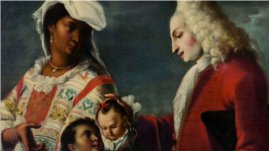Teachers' Domain - Digital Media for the Classroom and Professional Development
User: Preview

Source: Finding Your Roots: "Adrian Grenier, Michelle Rodriguez, and Linda Chavez"



NARRATION: We turned to New Mexico state historian, Rick Hendricks...
Rick suggested that we start our search in the 16th century-when New Mexico was first being settled by the Spanish-a time when mixing between Native Americans and Europeans was very common…
RICK HENDRICKS: There weren’t very many marriage partners to choose from. So from the beginning the men uh, made unions. Now, not always marriage, but they formed unions with Native American women. And from a practical standpoint, they didn’t have anybody else to choose from.
NARRATION: With Rick’s help, we were able to sift through the tangled family records of this period. Traveling back over four hundred years, we found Adrian’s maternal 11th great grandfather: Hernan Martin Serrano, one of the original Spanish settlers in New Mexico.
Adrian was astonished.
ADRIAN GRENIER: Really?
HENRY LOUIS GATES, JR.: Yeah.
GRENIER: Wow. That’s pretty epic!
NARRATION: We thought that Hernan might lead us to a Native American ancestor on Adrian’s family tree.
But our initial research turned up a very different kind of story.
Hernan was a sergeant in the army of Don Juan de Oñate-a man known today as “The Last Conquistador”-notorious for brutally subduing the Pueblo Indians.
GATES: How do you feel about having a Conquistador ancestor?
GRENIER: You know, I’ve been sort of touting the whole Native American thing for, for my whole life.
GATES: These are the Conquistadors, who were not exactly smoking the peace pipe with the Native Americans.
GRENIER: I don’t-I don’t identify with that spirit.
NARRATION: Adrian seemed pained to learn about this ancestor. And it turned out that his anxiety was well-founded.
In 1598, Oñate’s men got into a dispute with one of the Pueblo tribes, the Acoma Indians. Twelve Spaniards were killed. In response, Oñate and his soldiers struck back, killing hundreds of Acoma men, women, and children.
Then they turned on the survivors in an almost unimaginable way...
GATES: Oñate ordered his men to amputate the foot of every man over the age of twenty-five.
GRENIER: Whoa. That’s, that’s brutal. You know? I’d like to think that I was part of a more peaceful ancestry.
GATES: I mean, it was a war for survival. And it was a war for survival.
GRENIER: Yeah. And they had different values, absolutely.
GATES: Completely. A total clash of cultures.
GRENIER: Yeah.
NARRATION: But this horrible story led to a surprising revelation.
Hernan Serrano lived out his life in Santa Fe, New Mexico, dying sometime in the early 17th century, leaving behind a wife and several children.
And while searching for information about those children, we discovered something quite unusual about his son, Luis.
GATES: Could you turn the page?
GRENIER: I’m afraid to find out.
GATES: Can you read what that says?
GRENIER: (Reading) “Inquisition Record naming Luis Martin Serrano.”
GATES: Can you find the name of your 10th great-grandfather there?
GRENIER: Yep. “The Mestizo or Indio Luis Martin Serrano.”
GATES: Adrian, this document shows that people identified your ancestor as Mestizo or Indio meaning Indian.
GRENIER: Indian.
NARRATION: This record, from 1663, shows that even though Adrian’s ancestor entered New Mexico as a conquistador, he raised a family with a Native American woman.
Meaning that Adrian and his mother do indeed have native American ancestry after all!
GRENIER: I’m vindicated.
GATES: You are vindicated. Many of my guests pray that they’re Native American, claim that they’re Native American, but they ain’t Native American. But Adrian, you really are of Native American descent.
GRENIER: It’s nice to know that I, I you know, I was in fact connected to that lineage, but it was much more complex than I ever imagined.
NARRATION: We couldn’t track Luis’ story any further. But it illustrates a basic fact about the history of Spanish settlers and Native Americans: they often had children with each other.
The Spaniards who began pouring into the new world over 500 years ago didn’t arrive on an empty continent. And they didn’t bring many females with them.
So throughout the Americas, many Spanish settlers-either through rape or willing relationships-had children both with the Native Americans and their African slaves, filling their colonies with people who didn’t look particularly “Spanish.”
Then, to police genetic boundaries, the Spaniards constructed class systems based on color.
They invented terms like “Mulatto” and “Mestizo”…
And created elaborate anthropological paintings called “Castas” to describe these new racial mixtures...
…And they organized their societies to keep the whitest people in charge.
Whiteness was so important that people with limited mating choices sometimes married their own relatives rather than risk diluting the “purity” of their bloodline.
 Loading Standards
Loading Standards